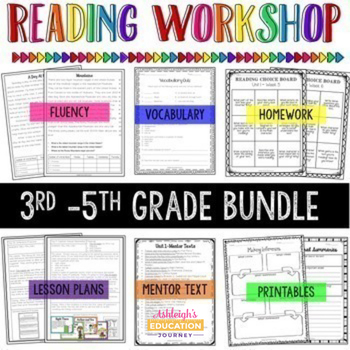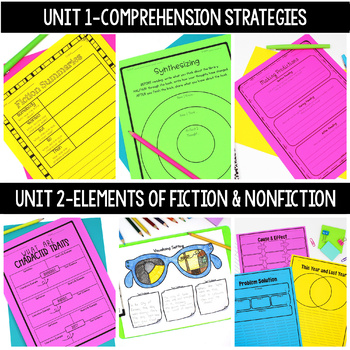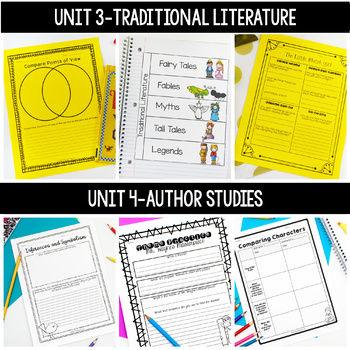3rd-5th Grade Reading Bundle | Print and Digital
- Zip
- Google Apps™

What educators are saying
Products in this Bundle (6)
showing 1-5 of 6 products
Bonus
Description
This reading bundle is designed to provide an entire year of detailed reading instruction for 3rd, 4th, and 5th grades! In addition to the PDF version of this file, there is a digital copy of all student files.
The reading units focus on comprehension, vocabulary, and fluency. The lessons are detailed and highly organized for ease of implementation.
***************************************************************************
What's Included?
Each of the six units includes 30 day-by-day lessons. Each lesson contains directions for a mini lesson, independent reading time, and closing. There is also an additional handout or guided practice activity for each of the lessons. These lessons will work with any guided reading or reading workshop classroom!
***************************************************************************
That's not all!
Each week of the reading bundle also includes the following:
-reading choice board for homework
-fluency passage
-vocabulary words and vocabulary quiz
All of the mentor texts are suggested texts. You may replace any of the texts with a book of your choice. I like to integrate my informational mentor texts with my social studies and science lessons.
***************************************************************************
Unit 1
- procedures
- visualizing
- connections
- asking and answering questions
- inferring
- predictions
- summarizing
Unit 2
- characterization
- setting
- plot
- nonfiction text features (table of contents, index, glossary, captions, diagrams, maps, insets, sidebars, hyperlinks, charts, and tables)
- nonfiction text structure (compare & contrast, cause & effect, sequential order, question & answer, problem & solution)
- main idea
Unit 3
Third grade lessons are taught through traditional literature: fables, fairy tales. tall tales, folk tales, myths, and legends.
- compare and contrast
- summarize
- using illustrations
- finding the central message
- identifying the speaker
- point of view (including first and third person)
- cause and effect
- supporting details
- figurative vs literal language
Unit 4
Unit 4 is organized around six author studies with one week of instruction for each author.
3rd Grade Version:
- Patricia Polacco
- Chris Van Allsburg
- Eve Bunting
- Seymour Simon
- Gail Gibbons
- Brian Floca
4th & 5th Grade Version:
- Patricia Polacco
- Chris Van Allsburg
- Eve Bunting
- Patricia C. McKissack
- Jacqueline Woodson
- Jerry Pallotta
Unit 5
- Figurative Langauge (similes, metaphors, idioms, proverbs & adages)
- Poetry (stanza, rhyme, meter)
- Prose
- Drama (cast of characters, stage directions, setting & description)
- Standardized Tests
Unit 6
- Includes one lesson from each of the language arts Common Core Standards (reading for literature and reading for information).
***************************************************************************
Vocabulary
Each week’s vocabulary instruction follows the same format to provide consistency and easy to follow routines. All vocabulary words are Tier 2 words from mentor texts in the reading units. Students create a vocabulary notebook or journal for their vocabulary words. The first few pages of the notebooks are used for a general word bank. The next set of pages include a word bank for prefixes and suffixes. The remainder of the notebook is for students’ weekly vocabulary practice.
- Monday-As a class produce brief definitions for each word.
- Tuesday-Brainstorm examples and non examples of each vocabulary word.
- Wednesday-Draw a picture representation of each word.
- Thursday-Students write words in high-quality sentences.
- Friday-Students take a brief vocabulary quiz over the six terms.
**************************************************************************************
Fluency
Since repeated reading is one of the best ways to improve students’ reading fluency, there is one fluency passage for each week of instruction. The fluency passages should be sent home on Monday, and students should read the passage orally to an adult each night of the school week. These passages may be sent home on an as-needed basis.
**************************************************************************************
Reading Centers/Literacy Centers and/or Reading Homework
There is a weekly choice board that can be used as part of your centers or as a homework assignment. As with all parts of this unit, the choice board is completely optional. On the choice board, there are 9 reading activities for students to choose from. You can set the parameters on what activities to complete, how many activities to complete, etc.





